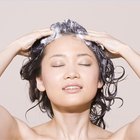Although hair relaxers can be a cause of damaged hair, some feel that with a relaxer their hair is straighter and thus more manageable. Fortunately, there are gentle relaxers available that have conditioning botanicals and can be used on damaged hair, however, they can still cause damage if used incorrectly. Damaged hair is typically brittle, porous, split and very fragile, so great care must be taken when using a relaxer.
Deep condition your damaged hair one week prior to relaxing it. If your hair is particularly porous, use a conditioning treatment that contains protein or keratin--these ingredients will strengthen and help protect your hair.
Purchase a relaxer that is gentle yet effective. These typically cost a bit more than normal relaxers, but they are the best option for damaged hair. Good choices include Phytospecific Phytorelaxer (use Index 1, which is for delicate hair), Elucence Gentle Relaxer and Soft & Beautiful Botanicals Relaxer. No matter what the texture of your hair is, do not get a relaxer formula that is for “coarse” hair, also known as a “super” formula--it is too strong for fragile hair and will cause further damage.
Thoroughly read the instructions on your relaxer, and check the box to insure that all of the elements, including the relaxer base, activator, shampoo, gloves and mixing stick, are included.
Perform a hair strand test as per the instructions for the relaxer you are using. Those with damaged hair cannot afford to skip doing a strand test--this will determine whether your hair can tolerate even a gentle relaxer.
If your hair does well with the strand test, proceed to apply the relaxer. Leave the relaxer on for two to four minutes less than the shortest recommended time. For example, if your relaxer suggests leaving it on your hair for 12 to 15 minutes, only leave the relaxer on for eight to 10 minutes.
Wash as much relaxer from your hair as possible with lukewarm water after the allotted time has passed--do this before shampooing. Gently shampoo your hair, and then use the included reconstructing conditioner. Do not skip this step, as your damaged hair will need the conditioning.
Roller set or allow your hair to air dry. If you plan to blow dry your newly relaxed hair, apply a heat-protecting serum, blow-dry cream, or split-end protectant while your hair is still damp. If you are going to flat iron your hair, apply a heat-protecting or flat-ironing serum while your hair is still damp.
Avoid relaxing your hair again for at least eight weeks. You should use a deep conditioner at least bi-weekly until your hair returns to a healthy state.
Related Articles

How to Condition Hair After Using a ...

Taming Over-Permed Hair

Products That Relax Curls

How to Stop Your Hair From Looking Dry ...

How to Keep My Hair From Getting Nappy

How to Make Wavy Hair Wavier

What Is the Best Shampoo for a Hair ...

How to Straighten Short Curly Hair in ...

How to Reduce Frizz in Permed Hair

How to Keep Your Hair Clean

How to Shampoo Hair After a Perm

How to Get Even Hair Color at Home

How to Relax Permed Hair

How to Get a Healthy Spiral Perm

How to Make Homemade Dead-Sea Salts ...

How Long Does a Hair Texturizer Last?

How Do You Minimize Scalp Irritation ...

What Is the Difference Between ...

How to Unlock Dreads

How to Loosen a Tight Perm
References
Writer Bio
Melinda Gaines has been a freelance writer since 2006, with work appearing online for YellowPages and other websites. Her areas of expertise include business, beauty, fashion and sports. Gaines attended the University of Houston where she earned a Bachelor of Science in sport administration.